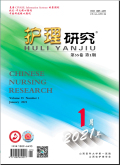护理研究2024,Vol.38Issue(1):8-16,9.DOI:10.12102/j.issn.1009-6493.2024.01.002
3种机器学习算法对维持性血液透析病人衰弱风险预测性能比较
Comparison of value of risk assessment models based on three machine learning algorithms in predicting frailty risk among maintenance hemodialysis patients
摘要
Abstract
Objective:To compare the value of risk assessment models based on Logistic regression,decision tree and random forest machine learning algorithms in predicting frailty risk among maintenance hemodialysis patients.Methods:From October 2021 to March 2022,a total of 485 patients receiving maintenance hemodialysis treatment in two tertiary grade-A hospitals in Hangzhou were selected and treated according to 7∶3 ratio was randomly divided into training set(n=341)and test set(n=144).Logistic regression,decision tree and random forest were used to establish frailty risk prediction models for maintenance hemodialysis patients.Accuracy,sensitivity,specificity,positive predictive value,negative predictive value,Kappa and AUC value were used to compare the predictive performance of the three models.Results:In the training set,the accuracy of Logistic regression,CART,and random forest were 91.79%,91.50%and 97.95%,the specificity was 96.84%,92.11%,and 96.91%,and the sensitivity was 85.43%,90.73%,and 99.32%,respectively.The positive predictive value was 95.56%,90.13%,96.05%,the negative predictive value was 89.32%,92.59%,99.47%,the Kappa value was 0.832,0.828,0.958,and the AUC value was 0.971,0.954,0.998.The AUC values of the three models were tested,and the results showed that the random forest model was significantly different from the other two models(P<0.05).Age,gender,Charlson Comorbidity Index and nutritional risk screening score were common predictors of the three prediction models.Conclusion:Random forest model is the best model in predicting frailty risk among maintenance hemodialysis patients.关键词
维持性血液透析/衰弱/预测模型/Logistic回归/决策树/随机森林Key words
maintenance hemodialysis/frailty/prediction model/Logistic regression/decision tree/random forest引用本文复制引用
汪丹丹,姚侃斐,祝雪花..3种机器学习算法对维持性血液透析病人衰弱风险预测性能比较[J].护理研究,2024,38(1):8-16,9.基金项目
浙江省卫生健康科技计划项目,编号:2022KY221 ()

